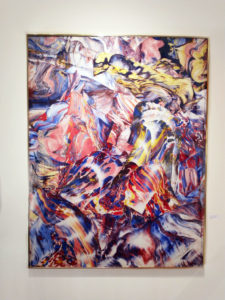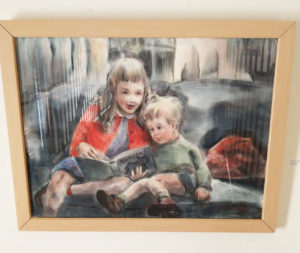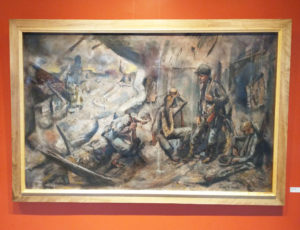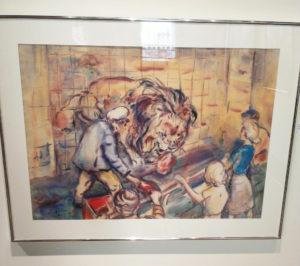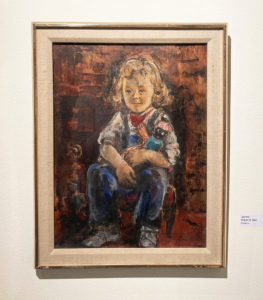On display at the Harold L. Olmsted Gallery through 5/31 | Reception 4/24, 6:30–8pm
“True art is the combination of the conscious and the unconscious.” –Bruce Allen Blair
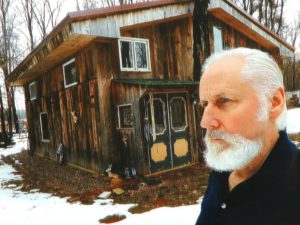 Bruce Allen Blair was born in 1951 to renowned Buffalo artists Robert Noel Blair and Jeanette (née Kenney) Blair. He studied at the Art Institute of Boston from 1970-1973, as well as with his father. An award-winning member of the Buffalo Society of Artists, Bruce Blair has exhibited extensively in the Western New York region, as well as nationally. Although he is well known for his airy watercolor landscapes, his work became more spontaneous over the years, and has been called a blend of impressionism and expressionism.
Bruce Allen Blair was born in 1951 to renowned Buffalo artists Robert Noel Blair and Jeanette (née Kenney) Blair. He studied at the Art Institute of Boston from 1970-1973, as well as with his father. An award-winning member of the Buffalo Society of Artists, Bruce Blair has exhibited extensively in the Western New York region, as well as nationally. Although he is well known for his airy watercolor landscapes, his work became more spontaneous over the years, and has been called a blend of impressionism and expressionism.
Blair’s personal collection of artwork is vast, including thousands of works of his father’s, his mother’s, local and national artists’, and his own. When combing through his endless collection of pieces for this exhibit, he expressed that he wanted to depart from the typical emphasis on landscapes so common in art exhibits. Instead, he selected portraits and other pieces that focused on people. The majority of the works are Robert Blair’s, and the stories behind them offer a glimpse into different aspects of humanity- war, celebrations, and daily life.
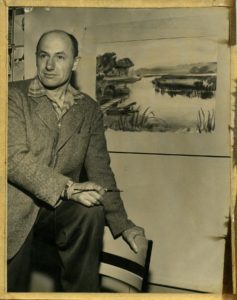 Robert Noel Blair was born in Buffalo, New York in 1912 to Charles Francis Blair, a lawyer, and Grace Ethelyn (nee McGonegal) Blair, a professor of Greek and Latin. He was interested in art from a young age, eventually taking art classes as a teen. He went on to study at the School of the Museum of Fine Arts in Boston, Massachusetts from 1931 to 1934, and then taught at many institutions in Buffalo including the Art Institute of Buffalo, Buffalo Fine Arts Academy at the Albright Art School, and the Buffalo Museum of Science, as well as several colleges and universities later in his life. A self-described pacifist, he was drafted into the army in 1940, where he was able to continue making art. Before he was shipped overseas, he married Jeanette in 1943, who he had met while they both taught at the Art Institute. They had three children: David F. Blair (1948-), Jeanne E. Blair (1945-1965), and Bruce A. Blair (1951-).
Robert Noel Blair was born in Buffalo, New York in 1912 to Charles Francis Blair, a lawyer, and Grace Ethelyn (nee McGonegal) Blair, a professor of Greek and Latin. He was interested in art from a young age, eventually taking art classes as a teen. He went on to study at the School of the Museum of Fine Arts in Boston, Massachusetts from 1931 to 1934, and then taught at many institutions in Buffalo including the Art Institute of Buffalo, Buffalo Fine Arts Academy at the Albright Art School, and the Buffalo Museum of Science, as well as several colleges and universities later in his life. A self-described pacifist, he was drafted into the army in 1940, where he was able to continue making art. Before he was shipped overseas, he married Jeanette in 1943, who he had met while they both taught at the Art Institute. They had three children: David F. Blair (1948-), Jeanne E. Blair (1945-1965), and Bruce A. Blair (1951-).
Robert won numerous fellowships and awards throughout his life, including two Guggenheim Fellowships (1946 and 1951) and ten Gold and Silver Medals with the Buffalo Society of Artists. He exhibited locally and throughout the United States extensively. His works can be found in The Metropolitan Museum of Art, Burchfield-Penney Art Center, Franklin D. Roosevelt Collection of Marine Paintings, Center of Military History, and many more institutions.
• • •
Liz and the Seahorse, 1993-94
Bruce Allen Blair
Collage
The only work in the exhibit by Bruce Blair himself, Liz and the Seahorse consists of multiple pieces of paper, marbleized with paint, collaged into an energetic display of color and movement. (There is a random friend hidden in this piece…can you find him?)
Bruce and Jeanne Blair, 1954
Jeanette Blair
Watercolor
This watercolor was done by Bruce’s mother, Jeanette Blair (née Kenney), when Bruce was three years old and his sister, Jeanne, was nine. Jeanette Blair was born in 1912 in Buffalo, New York. After graduating from East Aurora High School, she studied at the Art Institute of Buffalo from 1940 to 1943, where she met Robert Blair. Jeanette preferred to paint around her home in Western New York, focusing on the wildlife. She exhibited from the 1950’s until her death in 2016, in both solo and group shows. Jeanette was more known for her impressionistic landscapes, however this piece offers a sweet and simple glimpse into the Blair family.
Taking Shelter
Robert N. Blair
Oil
After being drafted into the army in 1943, Blair did a skit one night while at basic training. In the dark he would light a cigarette and use it as a paintbrush. His higher-ups were so impressed that he was promoted to corporal and then sergeant within four weeks, which allowed him the authority to carry his paints with him during active duty. He was in the airborne division as a paraglider, and was stationed in many countries in Europe during WWII. The majority of his WWII works were donated to the Burchfield-Penney Art Center in Buffalo, New York, although many remain in his son Bruce Blair’s personal collection.
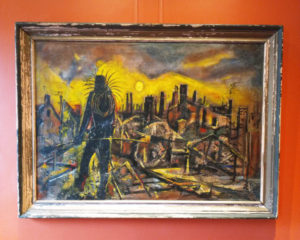 Chimney Sweep
Chimney Sweep
Robert N. Blair
Oil
After Robert Blair fought in the Battle of the Bulge, he went to occupy Berlin. Often, if he was unable to paint on the field he would make simple sketches which he would then use at a later date as inspiration for his paintings. This piece shows a chimney sweep standing amidst the bombed rubble of Berlin during the occupation. Although their homes were destroyed, civilians would still burn fires in their fireplaces for warmth, and the chimney sweeps would have to go around to clean the chimneys. The dark moody oils capture the dismal nature of war, however the yellow sun illuminating the wreckage offers hope.
Feeding Time, 1940
Robert N. Blair
Watercolor
During high school, Blair would ride his bike to the Albright Art School in Buffalo to take drawing classes. However, the learning style was very traditional, stressing charcoal drawings of models, which didn’t align with his desire for spontaneity. His favorite place to draw in Buffalo was the zoo, perhaps because the animals were the closest he could get to the ones he loved in Vermont.
This portrait is of Robert and Jeanette’s first child, Jeanne (1945-1965). She attended Syracuse University, and expressed her love of nature through poetry. After her tragic passing at age twenty, her family published a book of her poetry in 1966 titled Jeannie’s World. This sweet oil painting shows a very young Jeanne holding what appears to be a mammy doll. Although nowadays mammy dolls are recognized as racist artifacts, they were extremely common during the early 1900’s because of their representation of what children viewed as a comforting figure.
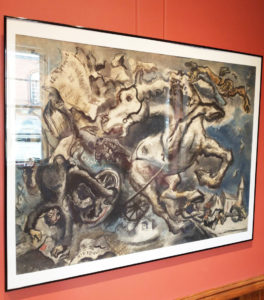 Giddy-up Silver, 1947
Giddy-up Silver, 1947
Robert N. Blair
Watercolor and ink
Bruce Blair explained that his father was photographing scenes in the city during his time as a teacher at the Art Institute of Buffalo. He decided to use the junkman as a subject, however the junkman saw Blair watching him, thought he was a CIA agent, and panicked. This painting is a dramatization of this amusing event.
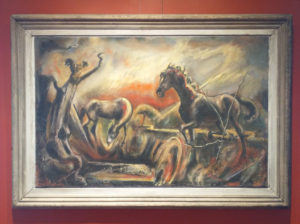 Storm Prelude, 1949-1958
Storm Prelude, 1949-1958
Robert N. Blair
Oil
Robert Blair traveled to his family’s 200-acre farm in Fletcher, Vermont almost every summer as a child. He began sketching in grammar school, and was especially inspired by the landscapes and animals there. As a teenager he received his first set of oil paints and taught himself the art, often working plein air on the farm. He particularly loved the horses which is evident in many of his pieces, including his work Horses In the Rain, which was purchased by the Metropolitan Museum of Art. Blair remained inspired by nature throughout his life, leaving Buffalo with his wife in 1946 to buy a house in South Wales, a rural area outside the city.
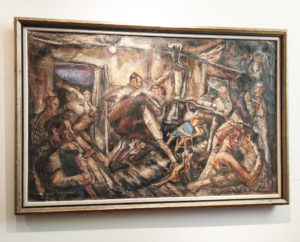 Kitchen Tunk, 1948
Kitchen Tunk, 1948
Robert N. Blair
Watercolor
Blair would often stay in Vermont after his family went home to Buffalo because he loved the way of life. The residents of Fletcher would have farmhouse parties called “kitchen tunks” where friends and neighbors would dance to fiddles, harmonicas, and other music. These gatherings were a key part of the social fabric of agrarian Vermont societies.
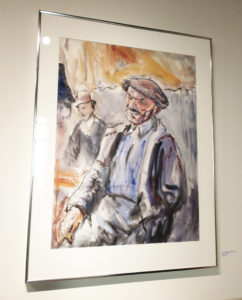 Bar at Lackawanna Steel Plant
Bar at Lackawanna Steel Plant
Robert N. Blair
Watercolor
Blair spent a lot of time at the Bethlehem Steel Plant in the late 1940’s sketching and painting the plant and the workers, and was commissioned in 1951 to paint a 12 by 9-foot oil-tempura mural of the open hearth there. The mural was removed when the plant closed, and transferred to an unknown location. During his time in the army he also completed an 800 square foot religious themed mural in a church in Alabama, where he was stationed, titled Sermon on the Mount. Robert Blair and Jeanette got married in front of the mural before Blair was shipped overseas.
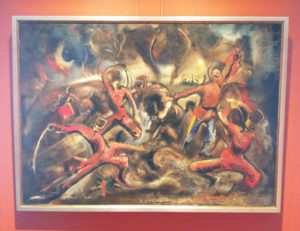 Sabre Dance, 1950
Sabre Dance, 1950
Robert N. Blair
Oil
This highly energetic piece was painted by Blair while listening to “Sabre Dance,” a movement from Aram Khachaturian’s ballet Gayane during which dancers demonstrate their skills with sabres. Sabre Dance is commonly known in the Western New York area as the theme song of the Buffalo Sabres hockey team, which makes this work a fun and relevant addition to the exhibit.
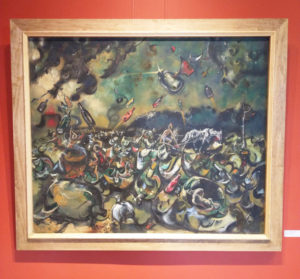 World of Glass, 1956
World of Glass, 1956
Robert N. Blair
Oil
Bruce Blair explained that his father was inspired by Hieronymus Bosch while painting this piece. Bosch was a Dutch painter born around the year 1450, whose most famous triptych is The Garden of Earthly Delights. Bosch’s work, though created during the Renaissance, is bizarre and fantastical, almost a prototype to surrealism. The figures appear to farm the bottles, dance around a cauldron, and lay amidst broken glass as bottles shoot into the air like rockets, evoking themes found in Bosch’s works.
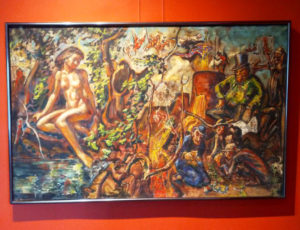 Diana and the Nuke Dump, 1973
Diana and the Nuke Dump, 1973
Robert N. Blair
Oil
According to Bruce Blair, his father created this work for an art show with a theme of “art and law.” There are numerous allusions to this idea throughout the piece, most notably the presence of Lady Justice in the upper right corner, the Four Horsemen of the Apocalypse in the sky, unsavory characters counting money and smoking, and what could possibly be Ayatollah Khomeini on a magic carpet. The focal point of the piece is a nude goddess lounging surrounded by nature. The bow at her side and the moon above her imply that she is Diana: the goddess of the hunt, the moon, childbirth, and crossroads.
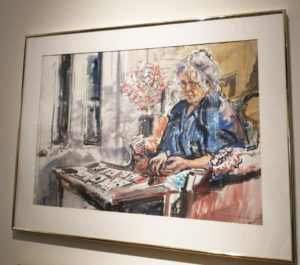 Grace Blair Playing Solitaire, 1970
Grace Blair Playing Solitaire, 1970
Robert N. Blair
Watercolor
Grace Ethelyn Blair (née McGonegal) was born in Rochester, New York in 1878. She graduated from Cornell University and taught Greek and Latin in Canandaigua, where she met Charles Francis Blair, a lawyer and professor. They married in 1906, and moved to Buffalo, where they purchased an Arts and Crafts stone home on Woodbridge Avenue. The Charles F. Blair house is located in the Central Park Neighborhoods in North Buffalo. This painting was done about a decade before Grace Blair died at age 102 in 1980 in Fletcher, Vermont.
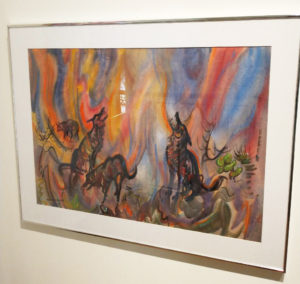 Coyote Chorus, 1980
Coyote Chorus, 1980
Robert N. Blair
Acrylic
Blair took his first motorcycle trip out west in 1964. He would memorize the landscapes as he rode, and also devised a method of sketching while driving so he wouldn’t forget anything. Although he was hospitalized for five months after a bad accident, he continued his travels by motorcycle through the decades. He became well known for his western-inspired watercolors, a contrast to his wartime works.
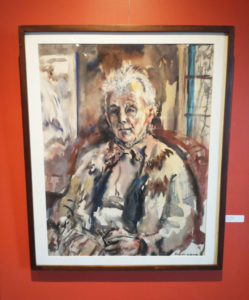 Harold Olmsted
Harold Olmsted
Robert N. Blair
Watercolor
Harold LeRoy Olmsted (1886-1972) was an artist, architect, lecturer, and teacher who was especially known for his landscape paintings. He was born in Buffalo, New York and went to Harvard University, where he received his B.F.A. after studying fine arts and architecture. He worked for Green & Wicks, the firm who originally designed the Albright Art Gallery, then as a landscape architect, and eventually as a freelance artist and consultant. He is known for designing the “Olmsted Camp” in Sardinia, New York, which still functions as a family estate. He resided in Springville from 1942 until his death, and was known as the “Sage of Springville” and “Grampa Olmsted.” The Olmsted Gallery located in Springville Center for the Arts was named for Harold L. Olmsted.
This event is listed within:












